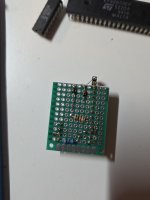Vintage Computer Club CH
Experienced Member
Still dead... time to check the DRAM?
Anyway, I figured out how the manuals are organised:
A000 and B000 locations (R32Ux) ROMs are listed in the "Monitor/Editor program listing" manual
F000 locations are for the "I/O ROM program listing" manual and what's in the manual matches with what I've got on my R32T3 ROM, therefore I would say the ROMs are in order
Anyway, I figured out how the manuals are organised:
A000 and B000 locations (R32Ux) ROMs are listed in the "Monitor/Editor program listing" manual
F000 locations are for the "I/O ROM program listing" manual and what's in the manual matches with what I've got on my R32T3 ROM, therefore I would say the ROMs are in order

